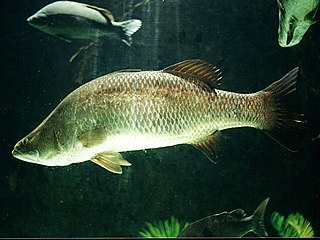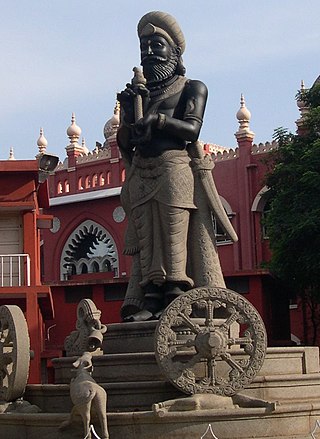
The barramundi, Asian sea bass, or giant sea perch is a species of catadromous fish in the family Latidae of the order Perciformes. The species is widely distributed in the Indo-West Pacific, spanning the waters of the Middle East, South Asia, Southeast Asia, East Asia, and Oceania.

The Latidae, known as the lates perches, are a family of perch-like fish found in Africa, Asia, and the Indian and western Pacific Oceans. Including about 13 species, the family, previously classified subfamily Latinae in family Centropomidae, was raised to family status in 2004 after a cladistic analysis showed the original Centropomidae were paraphyletic.

Ellalan, also referred to as Elara the Pious, and by the honorific epithet Manu Needhi Cholan, was a member of the Tamil Chola dynasty in Southern India, who upon capturing the throne became king of the Anuradhapura Kingdom, in present-day Sri Lanka, from 205 BCE to 161 BCE.

The Catholic Church in Sri Lanka is part of the worldwide Catholic Church, under the spiritual leadership of the pope in Rome. The country comes under the province of Colombo and is made up of 12 dioceses including one archdiocese. There are approximately 1.2 million Catholics in Sri Lanka representing around 6.1% of the total population. Later estimates suggest that there are over 1.6 million in 2020.
Gajabahu I, also known as Gajabahuka Gamani, was a Sinhalese king of Rajarata in Sri Lanka. He is renowned for his military prowess, religious benefactions, extensive involvement in South Indian politics, and for possibly introducing the cult of the goddess Pattini to Sri Lanka. The primary source for his reign is the Mahavamsa, though he is also the only early Sri Lankan king to be extensively mentioned in the Chera Cilappatikaram.
Gymnema lactiferum, the Ceylon cow-tree or Ceylon cow plant, is a species of climbing perennial shrub native to India and Sri Lanka. In Sanskrit it is called ksirakakoli. James Emerson Tennent described the use of the plant in his account of Ceylon, and wrote it was "evidently a form of the G. sylvestre". The milky juice of this plant has been said to be used as a substitute for milk and cream, but it is believed to contain enough of the poisonous principle peculiar to the order to cast a doubt upon this reputed use.
Most of the pre-modern coinage used in Sri Lanka or coins used in pre-Christian Sri Lanka can be categorised as punch-marked coins, tree and swastika coins, elephant and swastika coins and Lakshmi plaques.

The current legislative capital of Sri Lanka is Sri Jayawardenepura Kotte and the executive and judicial capital is Colombo. Over the course of the island's history, the national capital has been in several locations other thanSri Jayawardenepura Kotte.
Hulftsdorp is a suburb in Colombo, Sri Lanka. It is part of the postal area known as Colombo 12. It has been known historically as Hulffsdorp, Hulfsdorp, Hulftsdorp, Hulsdorp, Hulstsdorp and Hülffsdorf.
Hurulu Forest Reserve of Sri Lanka was designated as a biosphere reserve in January 1977. The forest reserve is an important habitat of the Sri Lankan elephant. Hurulu forest reserve represents Sri Lanka dry-zone dry evergreen forests. There are many other protected areas situated around Hurulu Forest Reserve viz. Ritigala strict nature reserve, Minneriya-Girithale and Mahaweli flood plains nature reserves, Wasgamuwa National Park and Kahalla-Pallekele sanctuary. Carved out at the edge of the Hurulu Forest Reserve is the Hurulu Eco Park which offers jeep safaris.
Handunnetti Rannulu Piyasiri was a Member of Parliament and a member of the Southern Province Council. He is also the current Sri Lankan Ambassador in Myanmar.
Mahinda VI (?–1187) was a king of the Kingdom of Polonnaruwa who came to the throne by killing his predecessor Vijayabahu II. He only reigned for five days, being killed by his successor and Vijayabahu II's sub-king, Nissanka Malla.
Significant events of national importance have been occasions for the issue of commemorative notes in Sri Lanka. The Central Bank of Sri Lanka has issued two commemorative notes. In 1998 a 200 rupees note was issued on Independence day to commemorate the 50th Independence Anniversary of the country. The note was issued along with three commemorative coins; a five thousand rupees gold coin, a one thousand rupees silver coin, and a ten rupees bi-metallic coin. The 200 rupees commemorative note was the first time a Sri Lankan note had been issued in polymer plastic produced by Note Printing Australia. The artwork was done by Ananda Somathilake and Gamini Mendis. Only a limited number of notes were issued. The note is being removed from circulation, and is rarely seen. Currently about 3% of the ~20.5 million notes issued are in circulation or with collectors.
The Six Dravidians were six Tamil rulers apparently from the Pandyan Dynasty who ruled the Anuradhapura Kingdom from 436 to 452 CE. They are said to be Buddhist, taking Buddhist epithets such as the 'servant of Buddha' and are known to have made several Buddhist donations.
Chandamukha Siva was King of Anuradhapura in the 1st century, whose reign lasted from 44 to 52. He succeeded his father Ilanaga as King of Anuradhapura.
Mahanama was King of Anuradhapura in the 5th century, whose reign lasted from 412 to 434. He succeeded his brother Upatissa I as King of Anuradhapura and was succeeded by his son Soththisena.
Aggabodhi II was King of Anuradhapura in the 7th century CE. His reign lasted from 608 to 618 CE.
Udaya II was King of Anuradhapura from 952 to 955. He succeeded Dappula V as King of Anuradhapura and was succeeded by his brother Sena III.
This is the family tree of Sinhalese monarchs.
Lates uwisara, the Myanmar sea bass, is a species of ray-finned fish from the family Latidae which is only known to occur in Myanmar. It is similar to the barramundi but its body is not as deep. It is a species of fresh and brackish waters. This species appears to have been widely utilised for aquaculture and so may be found as an escape in other regions, there are already records from French Polynesia where there are no native species of Lates.




